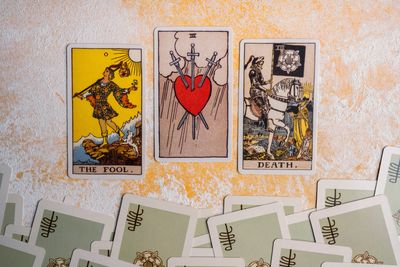Signed in as:
filler@godaddy.com
Signed in as:
filler@godaddy.com

The History and Art of Tarot Cards
The history of tarot cards is rich and complex, evolving over centuries and across different cultures. This educational guide provides an overview of the origins, development, and artistic aspects of tarot cards.
Early Beginnings
Origins in Playing Cards The earliest known tarot cards originated in the 15th century, likely in Italy. Initially created as playing cards for games rather than for divination, the term "tarot" is derived from the Italian word “tarocchi.”
Tarocchi Decks The earliest decks designed for gaming featured four suits, similar to contemporary playing card suits, along with a set of 22 trump cards referred to as “trionfi.” These trump cards eventually evolved into what we now recognize as the Major Arcana in modern tarot.
Evolution into Divination & Esoteric Associations
By the 18th century, tarot cards began to be linked with divination and the occult. Scholars and mystics, such as Antoine Court de Gébelin, proposed that tarot had ancient origins tied to Egyptian wisdom and mysticism, despite the lack of historical evidence supporting these claims.
The French Tarot: In France, the Tarot de Marseille gained prominence. This deck featured vivid imagery and symbolism, forming the basis for many contemporary tarot decks.
Golden Dawn Influence: In the late 19th century, the Hermetic Order of the Golden Dawn, a secret society, developed a system of tarot that integrated elements of Kabbalah, astrology, and other esoteric traditions. They created influential new decks, including the Rider-Waite tarot, which became widely recognized.
Modern Tarot: Rider-Waite Tarot
Designed by artist Pamela Colman Smith and published in 1909, the Rider-Waite deck is one of the best-known and most utilized tarot decks today. It emphasizes symbolism in the imagery of the Minor Arcana cards, making it more accessible for divination.
Rise of Interest
Throughout the late 20th and early 21st centuries, tarot gained significant popularity as a tool for self-reflection, personal growth, and spiritual development. Contemporary creators have developed alternative decks and reading styles reflecting modern themes, cultures, and artistic expressions.
The Art of Tarot
Tarot cards serve not only as tools for divination but also as works of art deeply imbued with symbolism and meaning. Here’s a closer look at the key components of tarot arts:
Structure of a Tarot Deck
Major Arcana: This collection consists of 22 cards that represent significant life themes, spiritual lessons, and archetypal energies. Cards like The Fool, The Magician, and The World are included, each with rich imagery and interpretations.
Minor Arcana: This set includes 56 cards divided into four suits, similar to traditional playing cards, with each suit representing various aspects of life:
- Cups: Emotions, relationships, and intuition.
- Wands: Creativity, action, and passion.
- Swords: Intellect, conflict, and challenges.
- Pentacles (or Coins): Material aspects, finances, and the physical realm.
Court Cards: Each suit contains court cards (King, Queen, Knight, and Page), which often represent people or personalities and can indicate roles or energies within a reading.
Symbolism and Imagery
Archetypes: Tarot cards utilize universal symbols and archetypes, such as the Hero’s Journey, to convey deep meanings. The images invite intuition and personal interpretation, making each reading uniquely resonant.
Color and Composition: Artists carefully choose colors to evoke specific emotions and meanings. Warm colors may signify energy or passion, while cooler colors can represent calmness or introspection.
Cultural and Personal Reflection: Many contemporary tarot decks reflect the creators' cultural, social, and personal experiences, providing fresh interpretations and perspectives on traditional messages.
Tarot Reading and Interpretation
Intuition
While established meanings exist for each card, tarot reading remains highly intuitive. Readers interpret cards based on their feelings, the questions posed, and the overall context of the spread.
Layouts and Spreads
Tarot readings can employ various layouts or “spreads,” where cards are arranged in specific patterns to address particular themes or questions. Common spreads include the three-card spread (past, present, future) and the Celtic Cross.
Connection and Context
Readers often emphasize building a connection with both the cards and the querent (the person asking the question) to access deeper insights during a reading.
The art of tarot combines a rich historical background with profound symbolism, making it both a tool for insight and a medium for artistic expression. Its evolution from a gaming deck to a revered instrument for self-discovery and divination reflects humanity's ongoing quest for understanding life's mysteries, self, and the universe.
Whether approached as a spiritual practice, psychological tool, or artistic endeavor, tarot continues to fascinate and inspire people worldwide.
For further exploration or resources on tarot history, reading techniques, or artistic interpretations, feel free to explore our additional educational materials or reach out to us with questions.
We use cookies to analyze website traffic and optimize your website experience. By accepting our use of cookies, your data will be aggregated with all other user data.